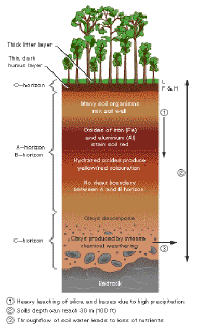The Malaysian Rainforest Soil Composition
Malaysian soils are so weathered that they are largely devoid of minerals like phosphorus, potassium, calcium, and magnesium, which come from "rock" sources, but are rich with aluminum oxide and iron oxide, which give tropical soils their distinctive reddish or yellowish coloration and are toxic in high amounts. Under such conditions, one wonders how these poor soils can appear to support such vigorous growth.Soil in the tropical rainforests is very nutrient poor. The topsoil is only one to two inches (2.5 to 5 centimeters) deep. The only reason plant life is so lush is because the plants store the nutrients in themselves rather than getting them from the soil. When plants decay, other growing plants tap the nutrients from the dead matter and reuse nutrients left over from that plant. This is why farmers can only use the rainforest soil for one or two years after they clear cut it, before all nutrients are stripped from the soil. The reason soils are so infertile is because they are more than 100 million years old, and have taken a beating from the elements. After time, rain washes minerals out of the soil, leaving them more acidic and nutrient poor. Soil exposed to the heat and condensed sunlight turns soil into red clay. Other soils just cannot deal with minerals, and turn them into compounds useless to plants. There are some fertile patches of soil in the rainforest, but they are scattered throughout the thick vegetation.


